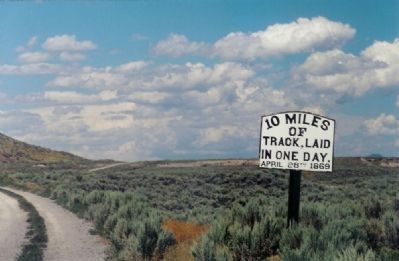Fascinating railroad trivia
November 12th, 2010 at 9:41 pm (Books, Travel)
 I recently finished the delightful “Making Tracks: An American Rail Odyssey,” which is one man’s tale of his trek via Amtrak across the U.S. in the mid-80’s — a travelogue interspersed with absolutely fascinating railroad history. Here are a few of the bits that stuck with me:
I recently finished the delightful “Making Tracks: An American Rail Odyssey,” which is one man’s tale of his trek via Amtrak across the U.S. in the mid-80’s — a travelogue interspersed with absolutely fascinating railroad history. Here are a few of the bits that stuck with me:
- The first transcontinental line was laid across the Rockies, not because it was the best or cheapest or easiest route, but because of (get this) the Civil War. An easier southern route through New Mexico and Arizona was the most likely choice, but then war broke out and all of the South became distrusted. And yet the transcontinental railroad was seen as a unifying goal, critical to holding us together as one nation. And so the Union Pacific line through Denver, Cheyenne, and Salt Lake City was born. Politics can bend even iron, it seems! Trains were also used extensively to transport troops during the war, and track sabotage (and repair) was rampant.
- Apparently there was actually a plan to put ICBMs on trains, as a way to make them mobile and therefore harder to take out preemptively. Wow.
“As of this writing, the final decision to place intercontinental ballistic missiles on railcars has not yet been made, but the plan is far enough along that the military already has designed a ‘Rail Garrison’ logo featuring a train superimposed on a missile, with an American flag, and two strands of Nebraska wheat with the inscription ‘Peacekeeper.’ The impetus for the plan is the fear of a possible enemy first strike that might disable the 1,054 missiles located in fixed concrete silos. […] When a launch order is received from the President, the train can stop in three minutes. It takes an additional five minutes to reorient the missile’s guidance system. During this time the car’s roof doors open and the missile is raised into firing position. With a blast of steam, the missile is ejected from its canister and then fires its engines above the train and begins its flight.”
 As late as the late 80’s (when the book was written), manual labor is/was used to adjust and repair track! A team can replace a tie in 7 minutes, which works out to 100 feet of track per day. A far cry from the 10 miles of track that Charles Crocker’s Chinese workers laid in 1869, but then that’s a record that’s never been surpassed.
As late as the late 80’s (when the book was written), manual labor is/was used to adjust and repair track! A team can replace a tie in 7 minutes, which works out to 100 feet of track per day. A far cry from the 10 miles of track that Charles Crocker’s Chinese workers laid in 1869, but then that’s a record that’s never been surpassed.
And there’s so, so much more to read and enjoy in this book. Highly recommended!
Here is a great critical summary of the book, and my own review as well.